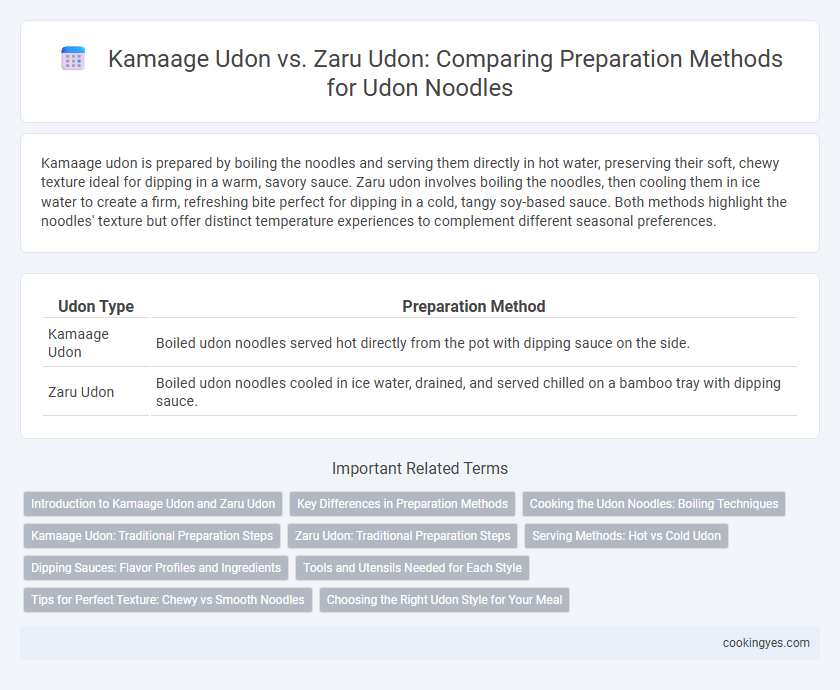Kamaage udon is prepared by boiling the noodles and serving them directly in hot water, preserving their soft, chewy texture ideal for dipping in a warm, savory sauce. Zaru udon involves boiling the noodles, then cooling them in ice water to create a firm, refreshing bite perfect for dipping in a cold, tangy soy-based sauce. Both methods highlight the noodles' texture but offer distinct temperature experiences to complement different seasonal preferences.
Table of Comparison
| Udon Type | Preparation Method |
|---|---|
| Kamaage Udon | Boiled udon noodles served hot directly from the pot with dipping sauce on the side. |
| Zaru Udon | Boiled udon noodles cooled in ice water, drained, and served chilled on a bamboo tray with dipping sauce. |
Introduction to Kamaage Udon and Zaru Udon
Kamaage udon features thick, chewy noodles served straight from the boiling water without being cooled, allowing the natural wheat flavor to shine. Zaru udon, in contrast, involves chilling the cooked noodles and serving them cold on a bamboo tray, enhancing their firm texture and providing a refreshing taste. Both methods highlight distinct sensory experiences of udon, emphasizing temperature and texture as key preparation differences.
Key Differences in Preparation Methods
Kamaage udon involves boiling freshly made udon noodles and serving them directly in hot water, preserving a soft and chewy texture. In contrast, zaru udon requires boiling the noodles, then rapidly cooling them in ice water to achieve a firm and springy bite. The dipping sauce for kamaage udon is typically warmer and simpler, while zaru udon is paired with a chilled dipping sauce to complement its cold presentation.
Cooking the Udon Noodles: Boiling Techniques
Kamaage udon involves boiling the noodles until tender and serving them directly in hot water, preserving their chewy texture and warmth. In contrast, zaru udon requires boiling followed by immediate rinsing in cold water to stop the cooking process, resulting in a firm and refreshing bite. The boiling time and temperature control are crucial for achieving the ideal texture specific to each preparation method.
Kamaage Udon: Traditional Preparation Steps
Kamaage udon features thick, freshly boiled noodles served directly from hot water without cooling, showcasing a softer texture and a warm, comforting bite. The traditional preparation involves cooking the udon noodles in boiling water, then draining them briefly before placing them in a communal bowl filled with the cooking water to retain heat. Dipping the noodles into a warm soy-based tsuyu sauce infused with dashi enhances the rich umami flavor, distinguishing it from the chilled and firm texture of zaru udon.
Zaru Udon: Traditional Preparation Steps
Zaru udon is traditionally prepared by boiling udon noodles until al dente, then immediately rinsing them under cold water to stop the cooking process and remove excess starch. The noodles are carefully drained and served chilled on a bamboo mat called a zaru, which enhances drainage and presentation. This method contrasts with kamaage udon, where noodles are served hot directly from the boiling water without rinsing.
Serving Methods: Hot vs Cold Udon
Kamaage udon features freshly boiled noodles served hot directly from the pot, accompanied by a warm dipping sauce, highlighting a comforting and hearty experience. Zaru udon presents cold, rinsed noodles chilled on a bamboo tray, paired with a cool soy-based dipping sauce, offering a refreshing and light alternative. The temperature contrast between Kamaage udon's steaming heat and Zaru udon's icy cool emphasizes regional and seasonal preferences in udon dining.
Dipping Sauces: Flavor Profiles and Ingredients
Kamaage udon is served hot with a warm dipping sauce made from dashi, soy sauce, and mirin, creating a rich, savory flavor that complements its soft texture. Zaru udon uses a chilled tsuyu dipping sauce, blending dashi, soy sauce, mirin, and sometimes grated ginger or wasabi, offering a refreshing and slightly tangy contrast. The temperature and subtle ingredient variations in the sauces highlight the unique flavors of each udon preparation.
Tools and Utensils Needed for Each Style
Kamaage udon requires a large pot to boil the noodles, a wire mesh strainer or ladle to scoop them directly from the hot water, and individual dipping bowls for warm dashi sauce. Zaru udon preparation involves boiling the noodles, using a colander to drain and cool them under cold water, followed by transferring them to a bamboo zaru tray that allows excess water to drain while serving. Both styles benefit from chopsticks designed for easy gripping of slippery noodles and small dipping cups for the cold or warm tsuyu sauce.
Tips for Perfect Texture: Chewy vs Smooth Noodles
Kamaage udon is served hot directly from the boiling water, preserving a chewy and firm texture ideal for dipping in thick, flavorful sauces. Zaru udon is cooled and rinsed under cold water, producing a smooth, slippery finish that enhances light, refreshing dips. Precise timing in boiling and immediate cooling or serving are essential to achieve the desired chewy or smooth consistency for each udon style.
Choosing the Right Udon Style for Your Meal
Kamaage udon features thick, chewy noodles served hot directly from the boiling water with a warm dipping sauce, offering a rich and comforting experience ideal for colder days or when craving warmth. Zaru udon is chilled and presented on a bamboo tray, paired with a cold soy-based dipping sauce that highlights the noodles' firm texture and refreshing simplicity, perfect for hot weather or lighter meals. Selecting between kamaage and zaru udon depends on desired temperature, texture preference, and seasonal suitability, ensuring the udon style complements the dining occasion.
Kamaage udon vs Zaru udon for preparation method Infographic

 cookingyes.com
cookingyes.com